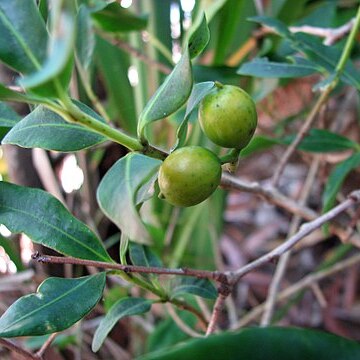Climber, more rarely an erect shrub. Bark brown or grey. Branchlets weakly or strongly angled, sparsely lenticellate or not, glabrous or sparsely and minutely puberulent. Leaves in whorls of 3 or 4; petiole 0.2-1 cm long, glabrous or pubescent; blade subcoriaceous or papery, elliptic or obovate, 2.4-9.2 by 0.9-3.6 cm, 1.5-5.3 times as long as wide, apex emarginate, rounded, obtuse, acute or shortly acuminate, not mucronate, base obtuse to cuneate, glabrous, sparsely puberulent only on midrib or puberulent all over beneath, glabrous or puberulent only on midrib above, secondary veins 17-40 pairs, 70-75° from midrib. Inflorescence axillary, with several clear internodes and unbranched side branches (but see note), delicate or robust, densely puberulent, especially further up the inflorescence, 1.2-3.2 cm long; peduncle 0.3-1.4 cm by 0.9-1.1 mm, weakly flattened, bracts caducous rarely persistent, deltoid or narrowly ovate, 1.9-2.6 by 1.3-2.6 mm, bracteoles one or two immediately beneath calyx, generally deciduous; flowers 12-15; pedicels 0.1-0.5 mm long. Sepals not fleshy, ovate or narrowly ovate, fused for up to half length at base, 1-2.2 by 0.6-1.2 mm, 1.4-3 times as long as wide, apex obtuse or acute, slightly reflexed, ciliate, sparsely or densely puberulent. Corolla white, yellow, white with an orange tube or greenish with a brown tube, fragrant; bud head 1.4-2.5 mm long which is 0.44-0.51 of bud length, ellipsoid or narrowly ovate, apex obtuse, acute or acuminate; tube cylindrical or slightly inflated, 2-2.7 by 0.8-1.25 mm, 1-2.4 times as long as sepals, 1-1.4 times as long as lobes, glabrous or sparsely puberulent around top of tube outside, pubescent in upper half and around stamens inside, sparsely pubescent around stamens and more densely in a band beneath them or very sparsely pubescent in upper half of tube; lobes elliptic or oblong, 1.6-2.4 by 0.5-1.2 mm, 2-4.6 times as long as wide, apex obtuse, acute or acuminate, glabrous outside and inside, not ciliate. Stamens inserted at 1.3-2.1 mm from corolla base which is 0.52-0.7 of tube length; filaments 0.2-0.6 mm long; anther apex 0-0.6 mm from corolla mouth, anthers 0.6-0.9 by 0.2-0.4 mm. Ovaries 0.4-0.7 mm high, densely pubescent all over or pubescent only on top; style 0.8-1.4 mm long; style head 0.2-0.6 mm long. Fruit yellow, black or yellow-orange; stalks 1-2.6 mm long; with 1 article, glabrous, with thin flesh, 9.2-10.5 by 6.9-9.5 mm, globose or subglobose, symmetrical, apex rounded. Seeds ovoid, 8.1-9 by 6-7.2 by 5.4-6.7 mm.
More
Scandent subshrub or woody liane. Leaves opposite or 3-or 4-whorled; lamina elliptic-lanceolate, elliptic-oblong, elliptic or obovate, to 100 mm long, to 40 mm wide, cuneate, not revolute, acute, obtuse or rounded, discolorous; secondary venation obscure. Inflorescence dichasially branched. Flowers 3–4 mm long, 3–4 mm diam. Sepals lanceolate-ovate, 0.9–2 mm long. Corolla cream to white; tube 2.5–3 mm long, 1–1.3 mm diam.; lobes lanceolate to obovate, 1.5–2 mm long, 0.5–1.2 mm wide. Stamens inserted 1–1.8 mm from top of tube. Fruits of 1 or 2 articles; articles globose, 7–13 mm long, 7–10 mm diam., glossy black when ripe, often remaining yellow for long periods.

